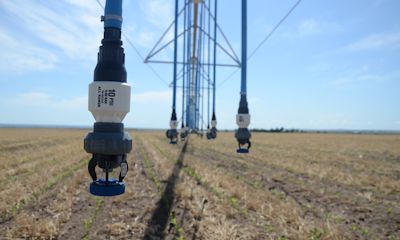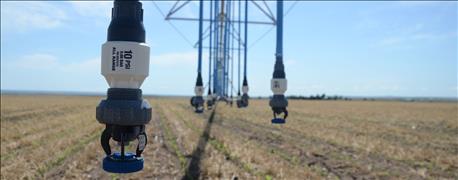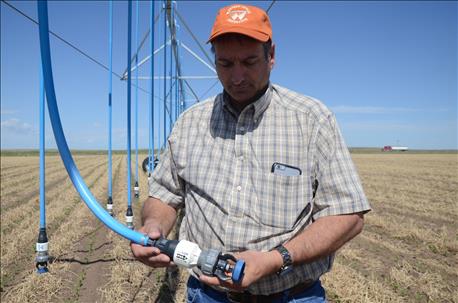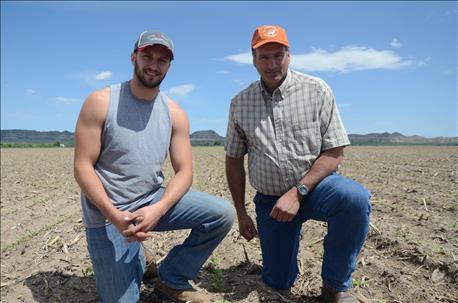
People driving on Highway 383 south of Bridgeport may have noticed an unfamiliar sight in the last year – a center pivot with drop nozzles hanging just 30 inches off the ground, accompanied by a sign highlighting the pivot's LEPA system. Last year it was watering sugar beets. This year, it's corn.

HANGING LOW: With LEPA, or low energy precision application systems, nozzles usually hang lower – in Nick Lapaseotes's case, about 30 inches off the ground, spaced about 30 inches apart from another. That means there's less chance for the wind to carry the water away, and more uniform distribution.
These systems are most often found on the southern High Plains in places like Texas, and that's where Nick Lapaseotes got the idea from when he installed the low energy precision application (LEPA) system on his farm near Bridgeport. Lapaseotes, who sits on the board of directors at 21st Century Equipment, a John Deere dealership in the Panhandle, first heard about the idea from a 21st Century Equipment technician who was familiar with these systems.
"He was from Texas and was familiar with working with LEPA systems and brought the idea to us," Lapaseotes says. "He explained that it's like a portable SDI system. This was a way to not go to full SDI but still improve irrigation efficiency. There's quite a difference in the cost of SDI versus the cost of a pivot."
It's that potential increase in water use efficiency that influenced Lapaseotes to install a LEPA system. Water is something that plays a major role in everyday life in western Nebraska, where rainfall comes at a premium, and soils are often coarser, sandier, and don't hold water as well. But for growers like Lapaseotes, whose son, Nicholas, came home to the family farming operation last year, it's especially important to preserve this vital resource for future generations.

EARLY INNOVATORS: Low energy precision application (LEPA) systems are most often found on the southern High Plains. However, in the last couple of years, Nick Lapaseotes (pictured) and his son Nicholas have used a LEPA system on this field near Bridgeport to irrigate sugar beets, and this year, corn.
Innovative irrigation management
For six years, Nick and Nicholas have used subsurface drip irrigation (SDI), including on a 75-acre field converted from a center pivot which had been gravity irrigated. In 2014, when it was planted in corn, Nicholas notes it out-yielded the pivot-irrigated field across the road by 20 bushels – and used 1.6 less inches. "We moved from pivot irrigation to SDI in order to irrigate all of the acres, where you couldn't with the pivot since you'd have corners that wouldn't be irrigated. SDI ends up being more efficient than both ravity irrigation and pivot irrigation," Nicholas says. "With SDI, you lose very little water if any at all to evaporation. It goes straight to the root system, and it hardly ever sees the surface."
~~~PAGE_BREAK_HERE~~~

MORE CROP PER DROP: For six years, Nick (right) and Nicholas Lapaseotes have used subsurface drip irrigation (SDI), including on this 75-acre field. In 2014, when it was planted in corn, Nicholas notes it out-yielded the pivot-irrigated field across the road by 20 bushels – and used 1.6 less inches.
This is their second year using a LEPA system, and although it will take a few years to quantify the benefits of this system, Nick says the evidence was already apparent in the first year of sugar beets. Under a LEPA system, sprinklers are about 30 inches from the ground, meaning there's less chance for the wind to carry the water away, and more uniform distribution.
"Under the LEPA system in sugar beets, the canopy and the ground seemed to stay consistently wet throughout the year. I think it's going to show it even more with corn," Nick says. "There's a pivot just down the road from the LEPA system and it used about an inch and a half less water on the LEPA system compared to one we had down the road three miles."
Progress in water use efficiency
Of course, water management takes a systems approach, and that system includes a combination of management practices, technology, and residue management and getting the crop rotation right.
For Nick and Nicholas, soil moisture sensors provided the evidence. Sugar beets are often considered a water-intensive crop, but with these practices, they've been able to keep their irrigation requirements on sugar beets down to about the same as corn – in recent years, with higher precipitation, roughly ten inches annually.
However, improvements in water use efficiency are something growers in western Nebraska have been continuously striving toward over the last 20 years, Nick adds. "In the last few years there have been a lot of pivots going up in the region. On gravity-irrigated fields, people are putting pivots in to save water and labor," he says. "I think western Nebraska has been a leader in water management."
And that push for greater efficiency continues as new technology comes down the pipeline and the next generation of irrigators adopts those technologies. "It's definitely revolutionary. The more challenges we have, the more you're going to have to find ways to do more with less," Nicholas says. "The same is true of water – we're achieving the same yields or better with less water."
Read more in the July Nebraska Farmer.
About the Author(s)
You May Also Like






